The reason why I woke up at exactly 5:20 was that I had to get up at such an hour in order to proceed further with the tour. For the next couple of hours we had the kidney resettlement experience again, but it was inevitable in order to get to the viewpoints from which it was possible to look at condors while they flew around.
Along the way, the coach stopped at a square in front of a church in some village and the local folk company did the performance at 6 o’clock in the morning! I did wonder why on earth they danced for some half-asleep group of tourists. And those same tourists were all in warm jackets while the tiny women the size of some primary school 4th graders were barefoot in some slippers. Brrrr!
The road practically runs parallel to the Colca river and in some broader pieces of land one can see cultivated fields in the form of terraces. Here they grow potatoes, maize and beans. It is said that in the Altiplano they have over 1000 types of potatoes and over 100 types of maize.
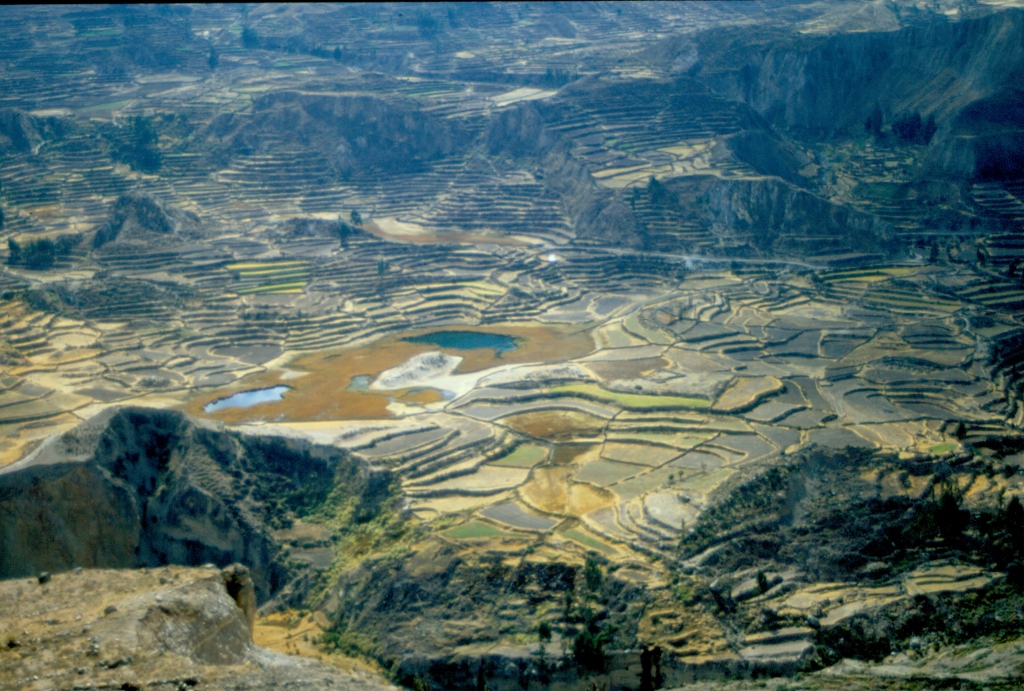 Terraced fields in the Colca Canyon
Terraced fields in the Colca Canyon
As we made photo-breaks along the way, I could see a whole bunch of coaches, since this is a very popular touring destination. The Colca Canyon is around 100 km long. Locally, they like to say that it is twice as big as the Grand Canyon in the USA. Here is what it is all about. It is, in a way, deeper and it is really big, but in fact it is not a proper canyon. A canyon is, at least this is what I learned at school, when a river vertically cuts down through a rock, thus making a passage for its course. When the rock is cut through at an inclined angle, then it is called a gorge. What one can see here is that the mountains on both sides of the river are indeed high (with peaks of over 5000 m), but these are simply two different mountains that got close to each other over time sufficiently for just one river to separate them or the river has simply found its way between two separate mountains. Even the sides are inclined, which would make it a gorge at best. Still, the official name is the Colca Canyon and it is indeed beautiful.
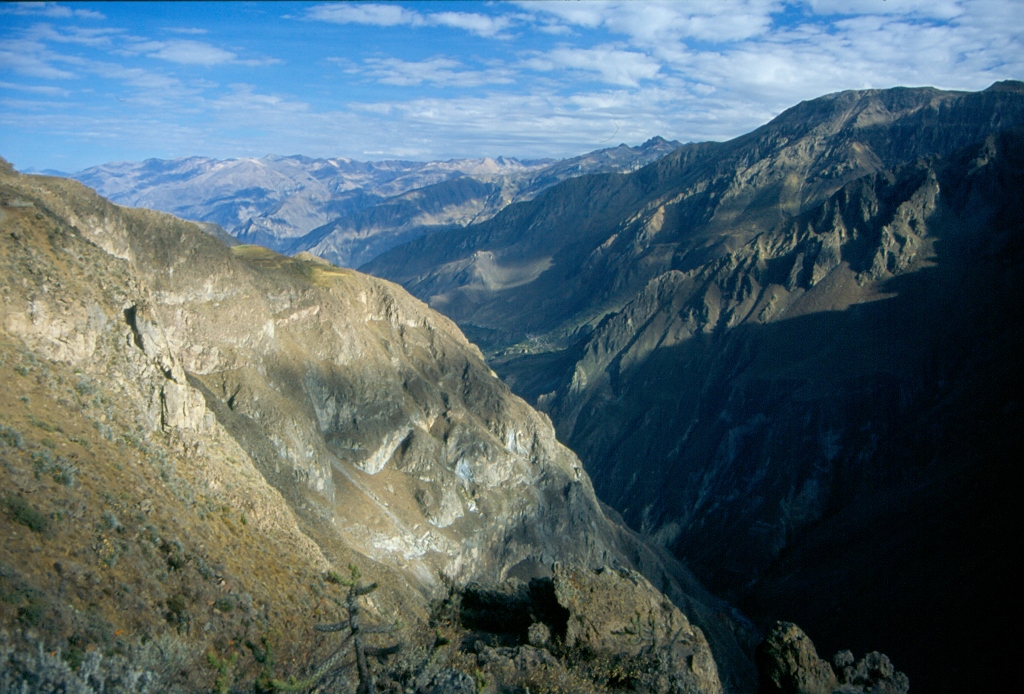 The Colca Canyon
The Colca Canyon
Few of us got off the coach earlier in order to make a mini-trekking for slightly less than an hour. Basically, just to be able to say we did it. But, it was no small feat. This was all happening at a little less than 4000 m a.s.l., so that even the slightest going up and down led to the fatigue of the material.
Along the canyon there are several small plateaus that serve as viewpoints connected by a path. The viewpoints were swamped by visitors and soon the condors appeared. Apparently, condors used to nest in more accessible places, but, as the story goes, pumas started to come and eat their eggs, which made condors withdraw to the vertical cliffs. I must say I find this suspicious, since pumas must have been here since forever. If anybody had bothered the condors, it must have been an increased number of tourists, but this is probably not too popular to say.
Condors are truly impressive birds. They are vultures that are the biggest birds that can fly. Their wing span can be as much as 3 metres. Most often they use thermals (warm rising air currents) in order to glide on them. Young condors are of brown colour and they change their feathers around the age of 8. Adults are black with a white collar. Males also have white feathers on the upper side of the wings. When they fly past you, they really appear imposing and as the day started to go by and the earth was getting warmer by the sun, they caught on the thermals and we could see several of them gliding high above us.
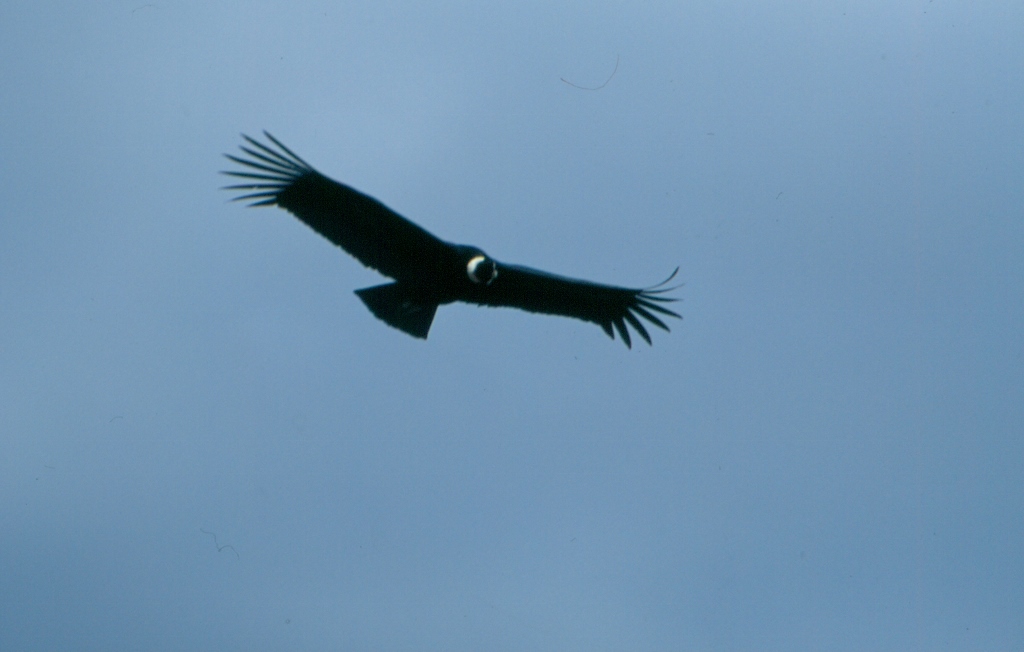 A condor in the Colca Canyon
A condor in the Colca Canyon
Looking at the condors I slowly made my way to the highest viewpoint where in addition to a crowd of tourists there were also a lot of local people selling crafts and souvenirs. And then suddenly I heard somebody yelling: “Berika! Berika!” Since I had already been used to my name being pronounced in such a way in Spanish, I looked around in puzzlement when all of a sudden I saw Marlon, the hostel-owner from Arequipa. He came there with a group with which he had headed off for a real trekking the day before with this viewpoint as its final destination. We then kissed and greeted very cordially and just as we parted suddenly there was a French guide I had sat next to on my way from Lima to Nasca who stayed at the same hostel in Arequipa as I. As he approached me, he said: “Un besito” (a small kiss). I could see that he had also mastered the first lessons in local customs, so I kissed with him as well. And then I thought to myself, Gosh, I was something else! – I’m known even in some god forsaken places that only condors inhabit.
On our way back we stopped at village Maca. There, by the church, the indigenous population in traditional clothes pulled alpacas along in order to pose for photos with tourists. Since we had some free time, I walked around for a while and there for the first time I became aware of a local anti-burglary system. Namely, the houses were mostly surrounded by tall walls, but that was not enough. Often, on top of these walls, one could see broken bottles and different other glass fixed there by plaster with the purpose of preventing burglars from climbing over.
After a while, the group gathered again and we went back to Chivay to have lunch. There I was with my pals from the evening before, but also with two couples from Australia and from Catalonia (this was what they said). We went for a lunch at a crummy place, but I found it interesting to “go with the crowd.” I would never opt for such a place, but I liked seeing what other people did. The point was that the price of lunch there was 2.5 sols (0.68 euro at the time), while the restaurant recommended by the guide offered a menu for 10 sols (2.75 euros). What I found interesting was that I could think of nobody from my country who would actually go to such a hole in order to save 2 euros. Maybe we are less adventurous or just have a complex of coming from a poor country which we then tend to overcompensate for. Be as it may, the lunch was quite OK.
Afterwards we headed back to Arequipa and the only remarkable thing was that we made a photo-break at the earlier mentioned pass that was the highest point of the road with its 4910 m above sea level. This was also the highest altitude I had been at with my lungs, but, since the area was flat and I made no sudden or accelerated moves, everything went well. By the way, there were some small stone towers all over the place and the guide told us that passing tourists had started who knows when to place groups of stones together, after the Himalayan customs, as symbols of some wishes of theirs. My only wish at the time was to get back to Arequipa. Although the whole tour was wonderful, except for the health horror of the night before, the trip was just far too long and I really looked forward to having done with the coach for the day.
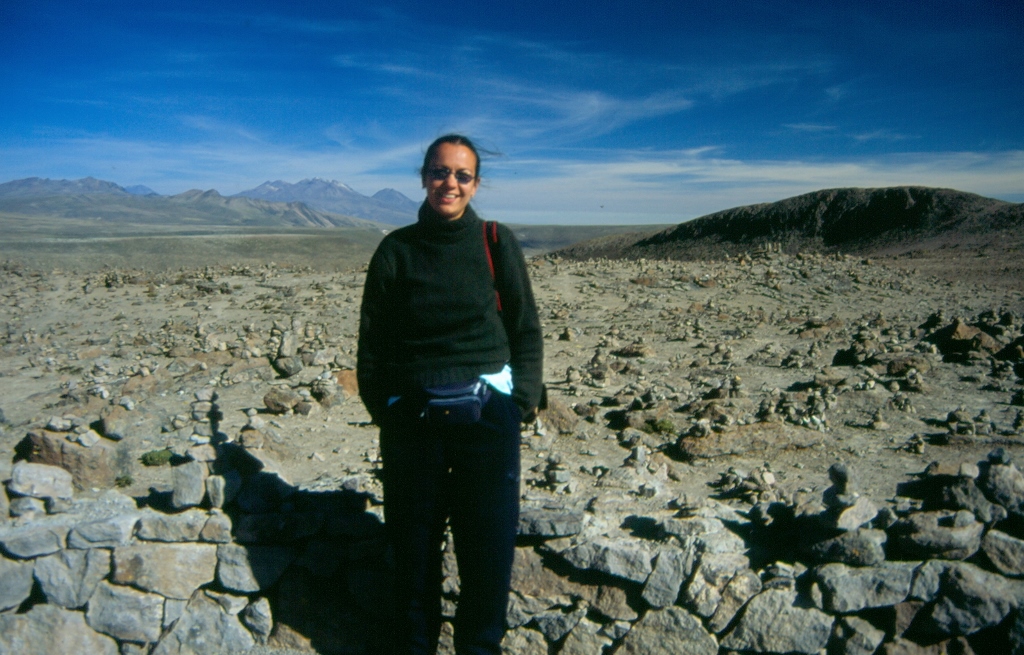 At 4910 m a.s.l.
At 4910 m a.s.l.
But, I had a new activity in Arequipa. In the meantime, I had agreed with a girl from Arequipa, Pilar, whom I found through internet, to get together in the evening. As it turned out, she was a very nice and kind person. I was not fully fit and my true self, on account of tiredness, running around and stress (I was almost late as we got back with a delay), and because of my wet hair (very stupidly on my part, I had a shower and went out in the cold with my hair still wet), but I did try. Pilar first took me to a friend of hers who had a travel agency to get some advice about my trip to Puno and afterwards we went to a very fine restaurant for dinner since I wanted to try one of their specialities “rocoto relleno” which are in fact stuffed peppers, small, red and – hot! It was quite tasty, but it was hot indeed. We didn’t stay there for too long, as Pilar astutely realized I was tired and had to get ready for the trip of the following day. We walked back to my hostel and she promised to come in the morning to see me off at the coach terminal. And so she did. We didn’t find the coach I had in mind, but we did find some other and everything went well.
On my way to the town of Puno, in some smallish place along the way, we came across a havoc on the road – some demonstrations and protests, road blockages, broken glass and rocks scattered all over the road, so we first stopped and remained there for a while. Then the coach moved and made its wobbly way following a bypass dirt road that led up and down and left and right. Several times.
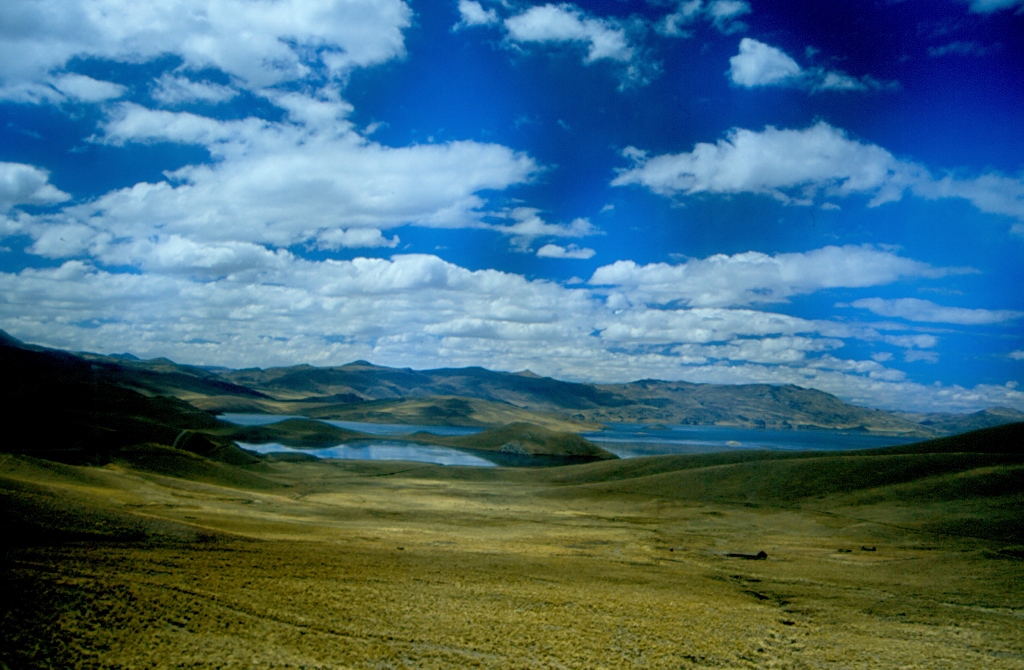 Landscapes between Arequipa and Puno
Landscapes between Arequipa and Puno
Yet, I arrived safely in Puno which is situated on the bank of lake Titicaca. This is the highest navigable lake in the world and its surface is at 3840 m above sea level. Ever since those infamous geography lessons back at primary school where I learned all those things about canyons and gorges, I’ve remembered lake Titicaca as part of the lessons on Peru and ever since then I’ve dreamed of coming to this lake. Nevertheless, having a healthy attitude to life, I decided to postpone my pleasure and to leave Titicaca, or at least its prominent Peruvian part, for later, after I came back from Bolivia.
As for Bolivia, I thought I would be able to continue in that direction the same day, but the coaches from Puno go there only in the morning. So I went out to have a short walk. In the meantime I caught cold and I was at considerable altitude, so I didn’t feel great, but I thought it would be quite silly to withdraw early to a rather plain and uninteresting hotel room I took. I went to the main square with the same name as all others, Plaza de Armas, with the local Cathedral. Then I walked along the Lima street that was quite lively. Although there are a lot of vendors in these places that are dressed in traditional clothes in line with the generally adopted marketing approach, it was quite clear walking there that there were women who obviously dress traditionally every day, but there were also a lot of women who were dressed in a “Western” way, if I can put it like this. Men tend to make less traditional choices when deciding on their clothes.
As I strolled around I saw some people gambling in the street and I remembered a very interesting tombola event, interesting for me at least, that took place in the coach between Nasca and Arequipa. It was obvious that people here loved to gamble and would not miss any opportunity for their hobby.
As it was getting late and dark, I eventually did go back to my hotel, particularly having in mind what the receptionist had told me and that was that streets were considered not to be too safe after 6 or 7 in the evening. Thus I managed to see a little bit of Puno, but unfortunately that evening I did not manage to reach Titicaca.
In the morning I headed for the town of Copacabana, Bolivia.